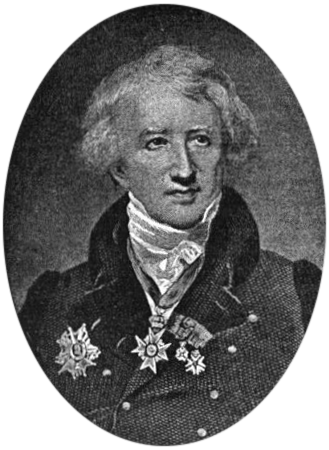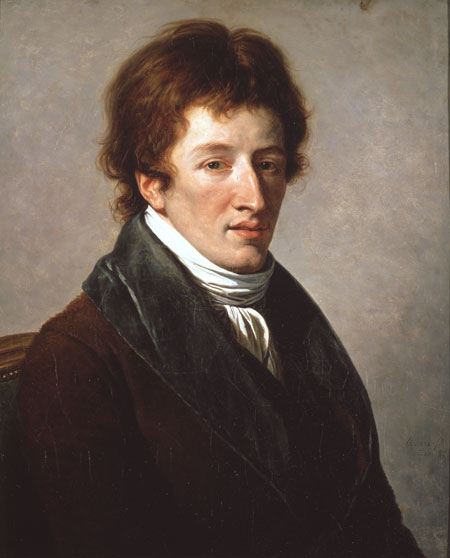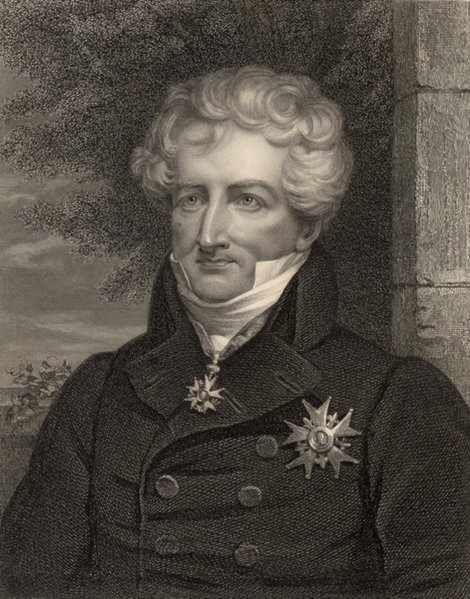<Back to Index>
- Naturalist Georges Léopold Chrétien Frédéric Dagobert Cuvier, 1769
- Sculptor Alexander Milne Calder, 1846
- Prime Minister of Greece Eleftherios Venizelos, 1864



Georges Léopold Chrétien Frédéric Dagobert Cuvier (August 23, 1769 – May 13, 1832) was a French naturalist and zoologist. Of working class origins, he belonged to a new class of self-made scholars who worked their way to the top of academe. Cuvier was a major figure in natural sciences research in the early 19th century, and was instrumental in establishing the fields of comparative anatomy and paleontology through his work in comparing living animals with fossils. He is well known for establishing extinction as a fact, being the most influential proponent of catastrophism in geology in the early 19th century, and opposing the gradualistic evolutionary theories of Lamarck and Geoffroy Saint-Hilaire. His most famous work is the Le Règne Animal (1817; English: The Animal Kingdom). In 1819, he was created a peer for life in honor of his scientific contributions. Thereafter he was known as Baron Cuvier. He died in Paris of cholera.
Cuvier was born in Montbéliard, France (in department of Doubs), where his Protestant ancestors had lived since the time of the Reformation, under the name of Johann Leopold Nicolaus Friedrich Kuefer. At the time the town, then named Mömpelgard, lay in the Duchy of Württemberg, but later became part of France (1805). He was the son of a retired military officer, who had served 40 years in the French army. His mother, who was much younger than his father, tutored him diligently throughout his early years so that he easily excelled the other children at school. During his gynasium years, he had little trouble acquiring Latin and Greek, and was always at the head of his class in mathematics, history, and geography. Soon after entering the gymnasium, at age 10, he encountered a copy of Gesner's Historiae Animalium, the work that first sparked his interest in natural history. He then began frequent visits to the home of a relation where he could borrow volumes of Buffon's massive Histoire Naturelle. All of these he read and re-read, retaining so much of the information that by the age of twelve "he was as familiar with quadrupeds and birds as a first-rate naturalist." He remained at the gymnasium for four years.
Cuvier spent an additional four years at the Caroline Academy in Stuttgart,
where he excelled in all of his coursework. Although he knew no German
on his arrival, after only nine months study he managed to win the
school prize for that language. Upon graduation, he had no money to
await appointment to academic office. So in July, 1788 he took a job in
Normandy as tutor to the only son of the Comte d'Héricy,
a Protestant noble. It was here during the early 1790s that he began
his comparisons of fossils with extant forms. Cuvier regularly attended
meetings held at the nearby town of Valmont for the discussion of
agricultural topics. There, he became acquainted with Henri Alexandre Tessier (1741–1837),
a physician and well-known agronomist who had fled the Terror in Paris
and assumed a false identity. After hearing Tessier speak on
agricultural matters, Cuvier recognized him as the author of certain
articles on agriculture in the Encyclopédie Méthodique and
addressed him as M. Tessier. Tessier replied in dismay, "I am known,
then, and consequently lost." — " Lost!" replied M. Cuvier; "no; you
are henceforth the object of our most anxious care." They
soon became intimate and Tessier introduced Cuvier to his colleagues in
Paris — "I have just found a pearl in the dunghill of Normandy", he
wrote his friend Antoine-Augustin Parmentier. As
a result Cuvier entered into correspondence with several leading
naturalists of the day and was invited to Paris. Arriving in the spring
of 1795, at the age of 26, he soon became the assistant of Jean-Claude Mertrud (1728–1802), who had been appointed to the newly created chair of comparative anatomy at the Jardin des Plantes. The Institut de France was founded in the same year, and he was elected a member of its Academy of Sciences. In 1796 he began to lecture at the École Centrale du Pantheon,
and at the opening of the National Institute in April, he read his
first palaeontological paper, which was subsequently published in 1800
under the title Mémoires sur les espèces d'éléphants vivants et fossiles. In this paper he analyzed skeletal remains of Indian and African elephants as well as mammoth fossils,
and a fossil skeleton known at that time as the 'Ohio animal'. Cuvier's
analysis established, for the first time, the fact that African and
Indian elephants were different species and that mammoths were not the
same species as either African or Indian elephants and therefore must be extinct.
He further stated that the 'Ohio animal' represented another extinct
species that was even more different from living elephants than
mammoths were. Years later, in 1806, he would return to the 'Ohio
animal' in another paper and give it the name mastodon. In his second paper in the year 1796, he would describe and analyse a large skeleton found in Paraguay, which he would name megatherium.
He concluded that this skeleton represented yet another extinct animal
and, by comparing its skull with living species of tree dwelling
sloths, that it was a kind of ground dwelling giant sloth. Together these two 1796 papers were a landmark event in the history of paleontology and in the development of comparative anatomy as
well. They also greatly enhanced Cuvier's personal reputation, and they
essentially ended what had been a long running debate about the reality
of extinction. In 1799 he succeeded Daubenton as professor of natural history in the Collège de France. In 1802 he became titular professor at the Jardin des Plantes;
and in the same year he was appointed commissary of the Institute to
accompany the inspectors general of public instruction. In this latter
capacity he visited the south of France; but in the early part of 1803,
he was chosen Permanent Secretary of the Department of Physical
Sciences of the Academy, and he consequently abandoned the earlier
appointment and returned to Paris. In 1806, he became a foreign member
of the Royal Society and in 1812, a foreign member of the Royal Swedish Academy of Sciences. He
now devoted himself more especially to three lines of inquiry: (i) the
structure and classification of the Mollusca; (ii) the comparative
anatomy and systematic arrangement of the fishes; (iii) fossil mammals
and reptiles and, secondarily, the osteology of living forms belonging to the same groups. In 1821, Cuvier made what has been called his "Rash Dictum":
he remarked that it was unlikely that any large animal remained
undiscovered. Many such discoveries have been made since Cuvier's
statement. At
the time Cuvier presented his 1796 paper on living and fossil
elephants, it was still widely believed that no species of animal had
ever become extinct, because God's creation had been perfect.
Authorities such as Buffon had claimed that fossils found in Europe of
animals such as the wooly rhinoceros and mammoth were remains of animals still living in the tropics (i.e. rhinoceros and elephants),
which had shifted out of Europe and Asia as the earth became cooler.
Cuvier's early work demonstrated conclusively that this was not the
case. Cuvier
came to believe that most if not all the animal fossils he examined
were remains of species that were now extinct. Near the end of his 1796
paper on living and fossil elephants he said: This led Cuvier to become an active proponent of the geological school of thought called catastrophism that
maintained that many of the geological features of the earth and the
past history of life could be explained by catastrophic events that had
caused the extinction of many species of animals. Over the course of
his career Cuvier came to believe that there had not been a single
catastrophe but several, resulting in a succession of different faunas.
He wrote about these ideas many times, in particular he discussed them
in great detail in the preliminary discourse (introduction) to a
collection of his papers, Recherches sur les ossements fossiles de quadrupèdes, on quadruped fossils
published in 1812. The 'Preliminary Discourse' became very well known
and unauthorized (and in the case of English not entirely accurate)
translations were made into English, German and Italian. In 1826 Cuvier
would publish a revised version under the name Discours sur les révolutions de la surface du globe. After Cuvier's death the catastrophic school of geological thought lost ground to uniformitarianism, as championed by Charles Lyell and
others, which claimed that the geological features of the earth were
best explained by currently observable forces, such as erosion and
volcanism, acting gradually over an extended period of time. However,
the increasing interest in the topic of mass extinction starting
in the late 20th century has led to a resurgence of interest among
historians of science and other scholars in this aspect of Cuvier's
work. Cuvier collaborated for several years with Alexandre Brongniart,
an instructor at the Paris mining school, to produce a monograph on the
geology of the region around Paris. They published a preliminary
version in 1808 and the final version was published in 1811. In this
monograph they identified characteristic fossils of different rock
layers that they used to analyze the geological column, the ordered
layers of sedimentary rock, of the Paris basin. They concluded that the
layers had been laid down over an extended period during which there
clearly had been faunal succession and that the area had been submerged under sea water at times and at other times under fresh water. Along with William Smith's
work during the same period on a geological map of England, which also
used characteristic fossils and the principle of faunal succession to
correlate layers of sedimentary rock, the monograph helped establish
the scientific discipline of stratigraphy. It was a major development in the history of paleontology and the history of geology.
In
1800, Cuvier was the first to correctly identify in print, working only
from a drawing, a fossil found in Bavaria as a small flying reptile, which he named the Ptero-Dactyle in 1809 (later Latinized as Pterodactylus antiquus) -- the first known member of the diverse order of pterosaurs. In 1808 Cuvier identified a fossil found in Maastricht as giant marine lizard, which he named Mosasaurus, the first known mosasaur. Cuvier speculated that there had been a time when reptiles rather than mammals had been the dominant fauna. This
speculation was confirmed over the next two decades by a series of
spectacular finds, mostly by English geologists and fossil collectors,
who found and described the first ichthyosaurs, plesiosaurs, and dinosaurs. In a 1798 paper on the fossil remains of an animal found in some plaster quarries near Paris Cuvier wrote: This
idea is sometimes referred to as 'Cuvier's principle of correlation of
parts', and while Cuvier's description may somewhat exaggerate its
power, the basic concept is central to comparative anatomy and
paleontology. For Cuvier, the principle of the correlation of parts was
theoretically justified by a further principle, that of the conditions d'existence,
usually translated as "conditions of existence." This was his way of
understanding function in a non-evolutionary context, without invoking
a divine creator. In the same 1798 paper he wrote: This principle later influenced the positivist philosopher Auguste Comte, and the physiologist Claude Bernard. Cuvier was critical of the evolutionary theories proposed by his contemporaries Lamarck and Geoffroy Saint-Hilaire,
which involved the gradual transmutation of one form into another. He
repeatedly emphasized that his extensive experience with fossil
material indicated that one fossil form does not, as a rule, gradually
change into a succeeding, distinct fossil form. Instead, he said, the
typical form makes an abrupt appearance in the fossil record, and
persists unchanged to the time of its extinction (this is the
well-documented paleontological phenomenon now referred to as
"punctuated equilibrium"). In
other words, Cuvier was a saltationist. While, like other
saltationists, he offered no explanation of how saltational evolution
might occur, he was skeptical of the gradual mechanisms of change that Lamarck and Geoffroy Saint-Hilaire proposed.
Moreover, his commitment to the principle of correlation of parts
caused him to doubt that any mechanism could ever gradually modify any
part of an animal in isolation from all the other parts (in the way
Lamarck proposed), without rendering the animal unable to survive. In his Éloge de M. de Lamarck (Praise for M. de Lamarck), Cuvier noted that Lamarck's theory of evolution He
also pointed out that Napoleon's expedition to Egypt had retrieved
animals mummified thousands of years previously that seemed no
different from their modern counterparts. "Certainly",
Cuvier wrote, "one cannot detect any greater difference between these
creatures and those we see, than between the human mummies and the
skeletons of present-day men." Lamarck
dismissed this conclusion, arguing that evolution happened much too
slowly to be observed over just a few thousand years. Cuvier, however,
in turn criticized how Lamarck and other naturalists conveniently
introduced hundreds of thousands of years "with a stroke of a pen" to
uphold their theory. Instead, he argued that one can only judge what a
long time would produce by multiplying what a lesser time produces.
Since a lesser time produced no organic changes, neither, probably,
would a much longer time. Cuvier's
claim that new fossil forms appear abruptly in the geological record
and then continue without alteration in overlying strata was used by
later thinkers to support creationism.
The abruptness seemed consistent with special creation by God (although
Cuvier's finding that different types made their paleontological debuts
in different geological strata clearly did not). The lack of change was
consistent with the supposed sacred immutability of "species", but,
again, the idea of extinction, of which Cuvier was the great proponent,
obviously was not. In
particular, he nowhere refers to the Bible in scientific argument. In
fact, his claims concerning past history often conflicted with
Scripture. A creationist would say that
the various life forms existing today are not only constant in form
over time, but also that they have been constant since "the Beginning."
Cuvier consistently argued the contrary (i.e., that new types regularly
replace older types in the fossil record). Cuvier explained the abrupt
appearance of new fossil forms in terms of immigration, not creation:
"I only say that they did not originally inhabit the places where we
find them at present, and that they must have come from some other part
of the globe".
Nowhere did he advance the hypothesis of successive new creations.
Moreover, since he consistently promoted
the idea that there has been a temporal succession of forms in the
geological record, he could not have believed the various life
forms that exist today were specially created "in the Beginning." Many writers have unjustly accused Cuvier of obstinately maintaining that fossil human beings could never be found. In his Essay on the Theory of the Earth,
he did say that "no human bones have yet been found among fossil
remains", but he made it clear exactly what he meant: "When I assert
that human bones have not been hitherto found among extraneous fossils,
I must be understood to speak of fossils, or petrifactions, properly so
called". Petrified bones, which have had
time to mineralize and turn to stone, are typically far older than
ordinary bones. Cuvier's point was that all human fossils that he knew
of were of relatively recent age because they 1) had not been petrified
and 2) had been found only in superficial strata. But he was not dogmatic in this claim. When new evidence
came to light, he included in a later edition an appendix describing a
skeleton that he freely admitted was an "instance of a fossil human
petrifaction". The
harshness of his criticism and the strength of his reputation continued
to discourage naturalists from speculating about the gradual
transmutation of species, right up until Darwin published The Origin of Species more than two decades after Cuvier's death. Apart from his own original investigations in zoology and paleontology Cuvier
carried out a vast amount of work as perpetual secretary of the
National Institute, and as an official connected with public education
generally; and much of this work appeared ultimately in a published
form. Thus, in 1808 he was placed by Napoleon upon the council of the Imperial University,
and in this capacity he presided (in the years 1809, 1811 and 1813)
over commissions charged to examine the state of the higher educational establishments in the districts beyond the Alps and the Rhine which
had been annexed to France, and to report upon the means by which these
could be affiliated with the central university. Three separate reports
on this subject were published by him. In his capacity, again, of
perpetual secretary of the Institute, he not only prepared a number of éloges historiques on
deceased members of the Academy of Sciences, but he was the author of a
number of reports on the history of the physical and natural sciences,
the most important of these being the Rapport historique sur le progrès des sciences physiques depuis 1789, published in 1810. Prior
to the fall of Napoleon (1814) he had been admitted to the council of
state, and his position remained unaffected by the restoration of the Bourbons.
He was elected chancellor of the university, in which capacity he acted
as interim president of the council of public instruction, whilst he
also, as a Lutheran,
superintended the faculty of Protestant theology. In 1819 he was
appointed president of the committee of the interior, and retained the
office until his death. In 1826 he was made grand officer of the Legion of Honour; he was subsequently appointed president of the council of state. Member of the Doctrinaires, he was nominated to the ministry of the interior in the beginning of 1832.